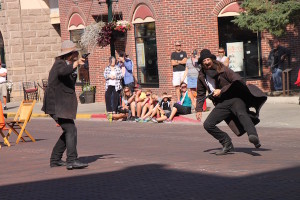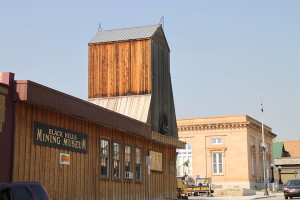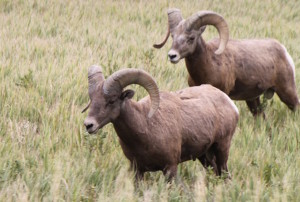As of this summer (2016), I have been in all 50 U.S. states. My sister and I treated ourselves to a driving trip to the last two on my list — North and South Dakota.
We spent most of our time in South Dakota, with a special interest in the Black Hills in the westernmost part of the state. Like most visitors, we aimed to see Mount Rushmore, historic mining towns and a lot of beautiful scenery.

More of the Black Hills’ famed scenic attractions. These formations in Custer State Park, called the Needles, were photographed through our car’s windshield.
Humongous sculptures
The presidential faces (left to right: Washington, Jefferson, [Theodore] Roosevelt and Lincoln) at the Mount Rushmore site looked stately and grand on our early morning visit. They were all the more admirable, however, after a visit to the on-site sculptor’s studio for an idea of the massiveness of the project. It is hard to fathom that artists used something resembling jackhammers for part of their work.

Our stone-faced presidents in stately formation on Mount Rushmore, with flags of all the U.S. states and territories in the foreground.
Also, a piece of trivia: Jefferson was to be to the left of the group, but the stone to the left of Washington’s head crumbled too much, so Jefferson is tucked in between Washington and Roosevelt. The four faces are 60 feet high and sit 500 feet above their admirers.
The project’s creator and lead sculptor was Gutzon Borglum. The work was completed after 14 years, in 1941, the year Borglum died.
For sheer size, the Crazy Horse sculpture, only 17 miles away, will overwhelm the Rushmore heads, with a projected length of 642 feet and height of 563 feet. It will show the murdered leader atop his horse. Only the face (87 feet, six inches tall) is complete.
My sister and I took in this scene from some distance. It’s not such a good idea for visitors to be too close to falling granite, but given the sculpture’s dimensions, the face was easy to see and, with a zoom lens, I could see the machinery that moves around on top of what will be Crazy Horse’s 263-foot outstretched arm. An on-site museum displays models of the finished work.

The far-from-completed granite sculpture of Crazy Horse, with large machinery clearly visible at the level where the arm will be.
Started in 1948, it is taking a very long time to complete, in part because of size but also, unlike Borglum’s enterprise, the Crazy Horse sculpture is an entirely private project.
The private funding also pays for the museum, which is quite large, as well as paying for educational and other support for American Indians. The founding sculptor was the late Korczak Ziolkowski, invited by Lakota Chief Henry Standing Bear to undertake the sculpture; Ziolkowski’s children continue the project.
Mining towns
We visited quite a few small towns in the Black Hills, most of which were born as mining towns in the 19th century.
Among tourists, Deadwood is the best known. The town certainly goes all out to attract visitors. Actors stage reenactments almost every day on Main Street and inside some of the historic buildings.
One such reenactment let us “witness” the murder of Wild Bill Hickok, which occurred in Deadwood’s original Saloon No. 10 in 1876, the same year the town was founded. Gold had been discovered nearby. My sister and I also watched a reenacted 1876 shootout called the 1876 Turkey Creek Altercation; the fight apparently arose during a card game.

During a shootout reenactment in Deadwood, one of the participants goes down after having been “shot.”
Deadwood’s early residents gambled without concern for legal niceties. Gaming was officially legalized here in 1988, and my sister exercised her option at the historic Celebrity Hotel on Main Street.
By displaying scantily clad dummies peering down from second-story windows, Deadwood highlights another local tradition. Deadwood’s town center was declared a National Historic Landmark in 1961, but it was another 19 years before the last brothels were shut down! Furthermore, that 1980 shutdown produced a demonstration in the streets.
Naturally, I liked Deadwood. I am a sucker for reenactments and for restored old towns.
But, I found the nearby Lead, a mining town of the same vintage, particularly appealing but for different reasons. The town name, BTW, is pronounced “leed,” referring to gold found on the ground’s surface, in other words, a lead to more gold underground.
Lead’s tourism focuses on the mining itself. Sightseeing begins at the Sanford Lab Homestake Visitor Center to view the open-cut gold mine, which preceded the underground kind. My sister and I joined the visitor center’s guided tour to Homestake’s underground mining site, though that does not mean going underground. We were looking at the above-ground hoist room (where the mine’s elevator is managed) and the mine shaft.

Mine shaft at the Homestake mine in Lead, S.D., now the site of the Sanford Underground Research Facility.
The mine’s below-ground spaces now accommodate a research laboratory, studying outer space without interference from above-ground magnetic fields, etc. The mine is 8,000 feet deep, though the lab isn’t. Water fills the bottom tunnels.
Over its lifetime (1877-2002), the mine produced nine million ounces of silver, plus 41 million ounces of gold that were refined and sold. The company built houses for workers but, our guide said, the houses had no basements because of a real risk that, with so much gold around, people would begin mining operations from their own basements. The last private owners gave the mine to the state on condition it would never be mined again.
Badlands
I have hardly mentioned North Dakota. My sister and I drove straight north from the Black Hills so I could clock my 50th state, but we did go far enough across the border to visit Badlands there that are part of the Theodore Roosevelt National Park.

Houses in Medora, a charming small town at the entrance to the Theodore Roosevelt National Park in North Dakota.
Given our trip originated and ended in Iowa, we had already driven through the South Dakota Badlands en route to the Black Hills. In both cases, these are beautiful and very rugged landscapes that early settlers found inhospitable. Hence, the name. We are fortunate these landscapes were so “undesirable.” We can still see them in their natural state — along with some nice wildlife, as it happens. I really liked the bighorn sheep.
For more about the Black Hills, we offer at BestTripChoices.com the following, under the headline: Where rock sculpture is big
https://besttripchoices.com/us-touring-areas/black-hillsmount-rushmore-south-dakota/
And for more about North Dakota, we offer at BestTripChoices.com the following, under the headline: Bad news, good news
https://besttripchoices.com/us-states/north-dakota/
This blog and photos are by Nadine Godwin, BestTripChoices.com editorial director and contributor to the trade newspaper, Travel Weekly. She also is the author of “Travia: The Ultimate Book of Travel Trivia.”






